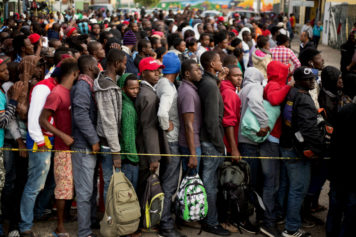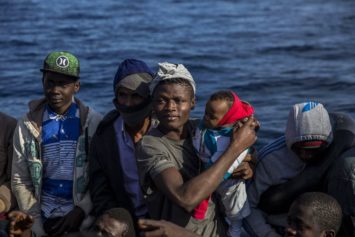On Nov. 9, in an extraordinary move, the German newspaper Der Tagesspiegel penned a powerful tribute to over 33,000 strangers, many of them African, by filling the pages of their popular European daily with a list of their names. Sadly, none were alive, given these migrants, asylum seekers and refugees all perished over the past 25 years in desperate attempts to cross the Mediterranean and reach what they believed to be a better and safer existence in Europe. Last year alone, the U.N. International Organization for Migration reported that more than 5000 died or went missing while trying to make the perilous journey. En route to their tragic demise, thousands would have passed through Libya, as the northern African nation represents the largest and most popular route for African migrants hoping to make it to the European continent.
And therein lies a significant part of the problem. In Libya — a country that has descended into civil war, a power vacuum and militia-based local rule since the U.S.-supported elimination of longtime leader Muammar Qaddafi in October 2011 — migrants escaping conflict or poverty from western African nations like Mali, Nigeria and Gambia risk a minefield of threats rivaling the hazardous crossing of the Mediterranean. Thousands end up in detention centers either operated by smugglers, militias or government security forces where they are far too often beaten, starved, extorted, killed or sexually abused. Others are forced into labor, some even ending up being sold in public slave markets. Consistently, UNICEF recently labeled the Central Mediterranean migration route through Libya as one of “the world’s deadliest and most dangerous migrant routes for children and women.”
“Those who are just arriving in Libya certainly don’t have the stability or the local connections to put together their own militias or defense forces,” said Mark P. Fancher, a civil rights attorney and blogger with a focus on the African continent. “So they become easy prey for people who want to enslave them or act out on racist feelings they already have.”
“They’re in a state of complete and utter helplessness,” reported Libyan attorney Shokri Agmar in 2016, noting, “whatever happens to them, no one will lift a finger, and they cannot keep a low profile because of the color of their skin.”
The Italian government recently lifted a finger, but it wasn’t a helpful one. In August, due to the relentless flow of African refugees and growing anti-migrant sentiment, it voted to deploy warships and financially support Libyan coast guard and militias with the interception and return of refugees to Libya.
“The Italian authorities have shown today that they consider it more important to keep refugees and migrants away from their shores than to protect their lives and welfare,” said Gauri Van Gulik, deputy European director for Amnesty International. “Facilitating the interception and return of refugees and migrants to Libya results in their arbitrary detention in centers where they are at almost certain risk of torture, rape and even of being killed.” Citing a recent investigation by his organization, Van Gulik blasted Italy for “providing military cover and support to the Libyan coast guard” and their documented “reckless and abusive conduct against refugees and migrants during interceptions.”
While the effect of the new policy has been a substantial decrease in the number of migrants taking the Libya-to-Italy route, several alternative and comparably dangerous routes have experienced a significant increase in migrant traffic. And, tragically, Italian officials were recently left wondering if the horrific discovery of the bodies of 26 teenage migrant girls in the Mediterranean is somehow a symptom of the new policy. They are not sure if the girls, all Nigerian and ranging from 14 to 18 years old, drowned during an attempted journey from Libya or were murdered along the way and dumped at sea.
A decade ago, though they certainly faced racism and discrimination, many Black foreigners arriving in Libya experienced a functional relationship with the longstanding Qaddafi-led government. Migrant workers from a number of western African nations commonly found work as construction workers, housemaids or street sweepers.
Many native Black Libyans felt less than welcome under Qaddafi. This was largely a result of an ongoing “Arabization” campaign that sought to eliminate indigenous cultures and languages while impacting the critical areas of citizenship, health care, education and employment.
“Before Qaddafi was assassinated, there was some preexisting animosity and bigotry toward Blacks in Libya, but he had managed to hold a lot of that in check,” said Fancher. He noted the late leader’s welcoming of a significant number of workers from western African countries “intensified” the attitudes of many Arab Libyans, ones “comparable to the sentiment you find in the U.S. towards those from Mexico and other Central American countries that cross the US border.”
All of this exploded during the Arab Spring of 2011 with the highly controversial targeting of Qaddafi by an Obama-backed NATO coalition along with local rebels, leading to the subsequent devolution of the formerly stable, 42-year regime into chaos. The African Union reported that Libyan rebels were indiscriminately killing Black people, whether native or migrant, because of perceptions they colluded with Qaddafi, who was accused of using foreign African mercenaries against opponents. Though the allegations lacked much evidence, they were nonetheless employed as a justification for the increasing and ongoing violence against anyone with dark skin in Libya.
“When the effort to overthrow him began in earnest, the United States, in looking for local people to arm and supply, did not hesitate to support groups who were not at all shy about saying that their objective was to purge Libya of the ABD, the Arabic term for slave,” explained Fancher. This, he said, facilitated “a systematic genocidal attack on communities of Black people in Libya prior to the overthrow” of the regime, one that “expanded after Qaddafi was assassinated.”
Tragically, such attacks have been normalized in a country still reeling from that internationally-imposed regime change six years ago. And although the number of migrants attempting the perilous Mediterranean crossing from Libya to Italy has substantially decreased with the new Italian policy, the deadly problem has merely been displaced as sea-bordering neighbors like Tunisia have increasingly become major exit points to Europe for those migrants channeled from Libya.
“The migrants are African and no one is interested in them,” said Tunisian fisherman Chamseddine Marzoug in a recent interview. Along with helping relief efforts for the masses of refugees now pouring into his country from Libya, Marzoug volunteers to retrieve and bury the bodies of migrants that wash ashore. “If it had been a man with blond hair and green eyes, you would all be interested.”
The fisherman stressed how the dollars being spent by Italy and other members of the European Union on border control could, instead, be more effectively invested in positively impacting people in the countries the migrants are fleeing.
“Don’t invest in the corrupt governments,” offered Marzoug, “but invest in the people.”


